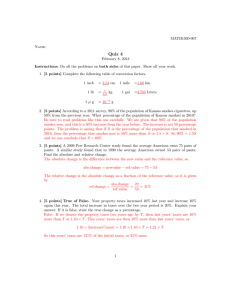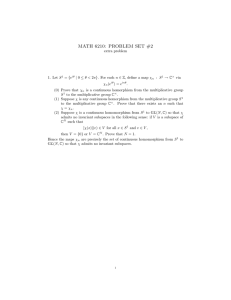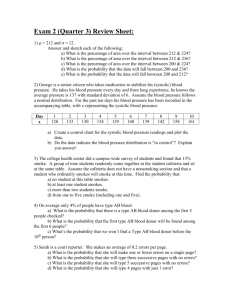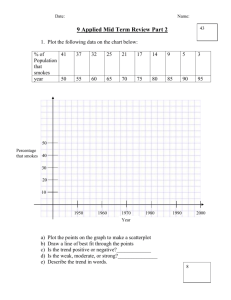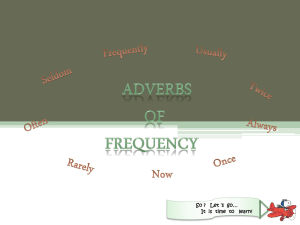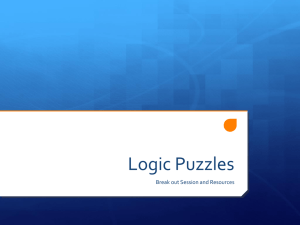One or two factor? - or something else? Ákos Münnich
advertisement
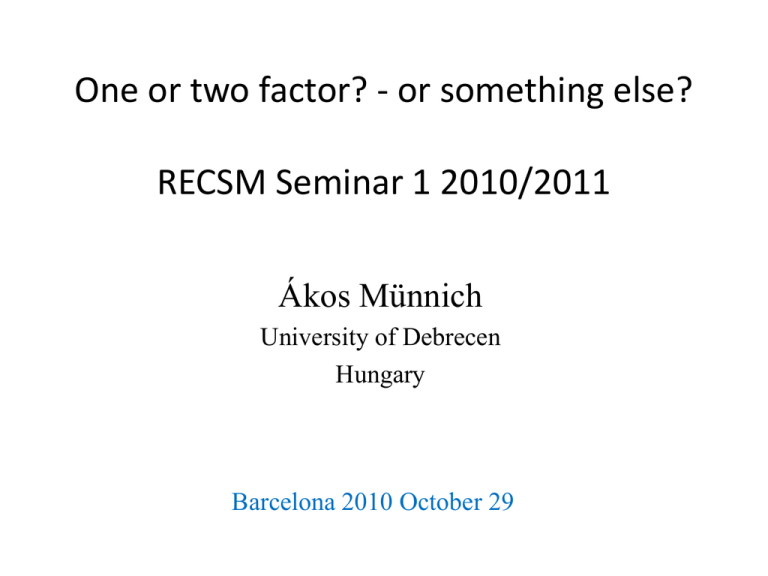
One or two factor? - or something else? RECSM Seminar 1 2010/2011 Ákos Münnich University of Debrecen Hungary Barcelona 2010 October 29 Experiment 2: subjective goodness of behavior People behave differently in a day, both good and bad. Please indicate on the line (of circles) how much they are good or bad for you. very bad very good 1. collect aid for the unemployed ooooooooooooooooooooooooooooooooooooooooooooooooooooooooooooooooooooooo 2. shouting to his parents ooooooooooooooooooooooooooooooooooooooooooooooooooooooooooooooooooooooo 3. help old people cross the road ooooooooooooooooooooooooooooooooooooooooooooooooooooooooooooooooooooooo 4. smokes a joint ooooooooooooooooooooooooooooooooooooooooooooooooooooooooooooooooooooooo 5. help in learning ooooooooooooooooooooooooooooooooooooooooooooooooooooooooooooooooooooooo 6. donate blood for a surgery ooooooooooooooooooooooooooooooooooooooooooooooooooooooooooooooooooooooo 7. help with the housework ooooooooooooooooooooooooooooooooooooooooooooooooooooooooooooooooooooooo 8. steal a good quality pen from a shop ooooooooooooooooooooooooooooooooooooooooooooooooooooooooooooooooooooooo 9. maintain the weaker ooooooooooooooooooooooooooooooooooooooooooooooooooooooooooooooooooooooo 10. drink wine 5 dl ooooooooooooooooooooooooooooooooooooooooooooooooooooooooooooooooooooooo 11. organize the class party ooooooooooooooooooooooooooooooooooooooooooooooooooooooooooooooooooooooo 12. smokes a pack of cigarettes ooooooooooooooooooooooooooooooooooooooooooooooooooooooooooooooooooooooo 13. ridicule the teacher ooooooooooooooooooooooooooooooooooooooooooooooooooooooooooooooooooooooo Subjective value of goodness of behaviors response range: 1 - 53 middle: 26 larger number means more positive valuation 1 collect aid for the unemployed 2 shouting to his parents 3 help old people cross the road 4 smokes a joint 5 help in learning 6 donate blood for a surgery 7 help with the housework 8 steal a good quality pen from a shop 9 maintain the weaker 10 drink wine 5 dl 11 organize the class party 12 smokes a pack of cigarettes 13 ridicule the teacher also principal factor analysis with promax rotation were used 1 factor: explained variance is about 26% 2 factors: explained variance is about 40% their correlation = -0.175 Factor weights 2-factor (promax rotation) behavior (good-bad) donate blood for a surgery help in learning help old people cross the road maintain the weaker help with the housework organize the class party collect aid for the unemployed drink wine 5 dl ridicule the teacher smokes a pack of cigarettes smokes a joint shouting to his parents steal a good quality pen from a shop 1-factor 1. faktor 2. faktor 0.796 0.742 0.683 0.785 0.801 0.628 -0.041 0.125 -0.178 0.681 0.653 0.531 0.436 0.051 -0.051 0.706 0.636 0.603 0.450 0.259 0.058 0.054 -0.061 0.176 0.031 0.624 0.344 -0.116 -0.183 -0.368 -0.418 0.067 0.004 -0.260 -0.267 0.604 0.643 0.379 0.586 "attitudes are commonly viewed as summary evaluations of objects (e.g., oneself, other people, issues, etc.) along a dimension ranging from positive to negative" "Attitudes are therefore first and foremost evaluations." "Attitudes are expressed in the language of 'like/dislike', 'approach/avoid', and 'good/bad'." - attitudes are not directly observable - attitudes can only be inferred from people's responses (so, we need proper measurement models and techniques) Mussweiler (2003): "Human judgment is comparative in nature. When people evaluate a given target, they don't do so in a vacuum. Rather, such evaluations are made within and in relation to specific context. In fact, any evaluation is relative in that it refers to a comparison of the evaluated target with a pertinent norm or stanfard." An axiomatic characterization of value judgments relative to a reference point Value judgment test situation • A subject is faced with a set of stimuli, and • asked to express his level of preference toward the stimuli in task-specific ways, • for example, by indicating on a line how much he likes or dislikes the amount of money offered for a particular job, or the length of a car. like dislike Value judgment test situation (assumptions) We suppose that the set of all possible stimuli are unidimensional parametric in the sense, that a (not necessarily directly observable) real number (e.g., in this example, the length of a car) is attached to them. The real number attached to the stimuli may reflect to a scale of a property of the stimuli (e.g., possible amounts of money offered for a specific job), and will be denoted by x, y, ... , and called stimulus parameter. This underlying property will be called the domain of the stimuli, and x<y means that y is more then x in the domain in question. Value judgment test situation (more assumptions) • The subject identifies a reference stimulus and then compares this reference stimulus (with parameter z) with the the test stimuli (with parameter x), and the result of the comparison is a real number, denoted by K(x,z). • In what follows, K is called a reference comparison function. • The parameter value z of the reference stimulus plays the role of a kind of reference point (or subjective standard, or status quo) in which the subject is more or less sure. • The result of the comparison K(x,z) is understood as the subjective value of the reference stimulus over the test stimulus. the key idea a reference point 0 z y – x = (z – x) – (z – y) → x y G(x,y) = H ( K(x,z), K(y,z) ) ? how does function K look like ? Unfortunately, the solution is too general, we need more specifications to obtain a closed formula for the reference comparison function K. Additive invariant comparison function • K is additive invariant if K(x+t,y+t)=K(x,y) • example: in calculating the profit, the total expenditures y can be regarded as the reference point, and the total incoming x is compared to the total expenditures. • The profit is calculated relative to the total expenditures, e.g. x-y. • Increasing the total incomings and the the total expenditures with the same amount will not change the profit: (x+t)-(y+t)=x-y. Multiplicative invariant comparison function • K is multiplicative invariant if K(x t,y t)=K(x,y) • example: the profit is not multiplicative invariant. Multiplying x and y with the same positive constant may substantially change the profit. (x t - y t < > x – y) • But a well known example is that the change rate between two currencies is multiplicative invariant. Additive and multiplicative comparison functions (assumptions) H additive invariant K multiplicative invariant additive invariant multiplicative invariant K(x+t,y+t)=K(x,y) H(u+r,v+r)=H(u,v) K(x+t,y+t)=K(x,y) H(ur,vr)=H(u,v) K(xt,yt)=K(x,y) K(xt,yt)=K(x,y) H(u+r,v+r)=H(u,v) H(ur,vr)=H(u,v) Solutions for the comparison functions (z is the reference point) Linear preference function and the reference point judgment 70 judgment 70 60 60 50 50 40 40 mean 30 A mean 30 reference point 20 20 10 10 B salary 25000 30000 35000 salary 40000 25000 30000 35000 40000 judgment 70 judgment 70 60 60 A A 50 50 B B 40 40 mean 30 20 20 10 10 salary 25000 30000 35000 mean 30 40000 salary 25000 30000 35000 40000 Log and Exp preference functions Log function Exp function reference point = 1 reference point = 1 orientation = -4.5 orientation = -0.25 12 12 10 10 8 8 6 6 4 4 2 2 2 4 6 8 10 2 4 6 8 10 Testing the models by experiments Experiment 1: subjective value of salary Experiment 2: subjective goodness of behavior Experiment 3: attitude towards pollution and two more example: employee loyality political behavior Experiment 2: subjective goodness of behavior People behave differently in a day, both good and bad. Please indicate on the line (of circles) how much they are good or bad for you. very bad very good 1. collect aid for the unemployed ooooooooooooooooooooooooooooooooooooooooooooooooooooooooooooooooooooooo 2. shouting to his parents ooooooooooooooooooooooooooooooooooooooooooooooooooooooooooooooooooooooo 3. help old people cross the road ooooooooooooooooooooooooooooooooooooooooooooooooooooooooooooooooooooooo 4. smokes a joint ooooooooooooooooooooooooooooooooooooooooooooooooooooooooooooooooooooooo 5. help in learning ooooooooooooooooooooooooooooooooooooooooooooooooooooooooooooooooooooooo 6. donate blood for a surgery ooooooooooooooooooooooooooooooooooooooooooooooooooooooooooooooooooooooo 7. help with the housework ooooooooooooooooooooooooooooooooooooooooooooooooooooooooooooooooooooooo 8. steal a good quality pen from a shop ooooooooooooooooooooooooooooooooooooooooooooooooooooooooooooooooooooooo 9. maintain the weaker ooooooooooooooooooooooooooooooooooooooooooooooooooooooooooooooooooooooo 10. drink wine 5 dl ooooooooooooooooooooooooooooooooooooooooooooooooooooooooooooooooooooooo 11. organize the class party ooooooooooooooooooooooooooooooooooooooooooooooooooooooooooooooooooooooo 12. smokes a pack of cigarettes ooooooooooooooooooooooooooooooooooooooooooooooooooooooooooooooooooooooo 13. ridicule the teacher ooooooooooooooooooooooooooooooooooooooooooooooooooooooooooooooooooooooo Subjective value of goodness of behaviors response range: 1 - 53 middle: 26 larger number means more positive valuation 1 collect aid for the unemployed 2 shouting to his parents 3 help old people cross the road 4 smokes a joint 5 help in learning 6 donate blood for a surgery 7 help with the housework 8 steal a good quality pen from a shop 9 maintain the weaker 10 drink wine 5 dl 11 organize the class party 12 smokes a pack of cigarettes 13 ridicule the teacher the order of the behaviors are not obvious !! the starting value of the behaviors were intuitive starting value of the orientation parameter = -1 (because in the model it has a negative coefficient, and so, it will be increasing) K(x,z) = γ(z – x) + ω = (γz + ω) – γx Group means, standard error of mean Parameters of behaviors behaviors (good-bad) donate blood for a surgery help old people cross the road help in learning maintain the weaker help with the housework organize the class party collect aid for the unemployed ridicule the teacher drink wine 5 dl smokes a pack of cigarettes smokes a joint shouting to his parents steal a good quality pen from a shop parameter value initial value original order of the questions 4.98 3.63 3.60 3.37 3.12 2.06 1.89 -1.16 -1.53 -3.04 -4.77 -6.04 -6.12 6 5 4 3 2 1 0 -1 -2 -3 -4 -6 -5 6 3 5 9 7 11 1 13 10 12 4 2 8 Overall fit (R2=0.86) Observed and estimated fit by groups group 3 7 12 19 22 24 26 28 29 30 correlation 0.82 0.89 0.91 0.91 0.80 0.90 0.88 0.97 0.95 0.94 R2 0.67 0.79 0.82 0.83 0.64 0.81 0.77 0.94 0.91 0.88 reference point orientation -2.55 16.0 -2.09 -0.27 -0.57 -1.87 -1.07 -0.40 1.25 0.71 -2.93 -0.90 -2.91 -3.95 -0.79 -3.85 -3.74 -5.19 -3.10 -3.39 Group 19 all the groups (linear and group 19 nonlinear) also principal factor analysis with promax rotation were used 1 factor: explained variance is about 26% 2 factors: explained variance is about 40% their correlation = -0.175 Factor weights 2-factor (promax rotation) behavior (good-bad) donate blood for a surgery help in learning help old people cross the road maintain the weaker help with the housework organize the class party collect aid for the unemployed drink wine 5 dl ridicule the teacher smokes a pack of cigarettes smokes a joint shouting to his parents steal a good quality pen from a shop 1-factor 1. faktor 2. faktor 0.796 0.742 0.683 0.785 0.801 0.628 -0.041 0.125 -0.178 0.681 0.653 0.531 0.436 0.051 -0.051 0.706 0.636 0.603 0.450 0.259 0.058 0.054 -0.061 0.176 0.031 0.624 0.344 -0.116 -0.183 -0.368 -0.418 0.067 0.004 -0.260 -0.267 0.604 0.643 0.379 0.586
